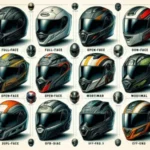When it comes to motorbikes, the thrill of the ride is often matched only by the importance of safety, and one of the most critical components ensuring that safety is the braking system.
Understanding the various types of motorbike brakes can enhance not only your riding experience but also your overall safety on the road. From traditional disc brakes that offer reliability and precision to the advanced anti-lock braking systems (ABS) designed to prevent wheel lockup during sudden stops, each braking technology has its own unique characteristics and effectiveness. In this blog post, we will delve into the different types of motorbike brakes, exploring how they work, their advantages and disadvantages, and the impact they have on your riding performance. Whether you’re a seasoned rider looking to upgrade your bike or a newcomer eager to learn more about motorbike mechanics, this comprehensive guide will equip you with the knowledge to make informed decisions and ride with confidence.
1. Introduction to Motorbike Braking Systems
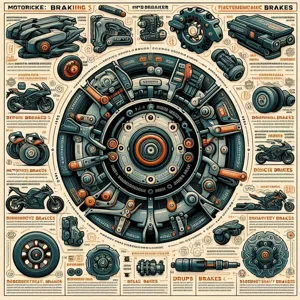
The braking system is one of the most critical components of a motorbike, directly influencing both safety and performance. As riders, we often take for granted the mechanics that allow us to slow down or come to a complete stop, but understanding the various types of braking systems can make a significant difference in our riding experience.
Motorbike brakes can broadly be categorized into two main types: mechanical and hydraulic. Mechanical brakes, often found in older or simpler models, rely on a cable system to engage the brake pads against the rotor, offering a straightforward yet effective means of deceleration. On the other hand, hydraulic brakes represent the pinnacle of modern braking technology, utilizing fluid pressure to create a more responsive and powerful braking action. The intricacies of hydraulic systems often lead to enhanced performance, allowing for smoother stops and better modulation.
Within these categories, there are further distinctions among different brake types, including disc brakes and drum brakes, each with their own unique advantages and drawbacks. Disc brakes, which have become the standard for most modern motorcycles, provide superior heat dissipation, reduced fading under heavy use, and more consistent stopping power. In contrast, drum brakes, while less common on high-performance bikes, still hold value in certain applications, offering durability and reliability, particularly in low-speed situations.
In this post, we’ll delve deeper into these braking systems, exploring how each type works, their effectiveness in various riding conditions, and what factors you should consider when selecting or maintaining the brakes on your motorbike. Whether you’re a seasoned rider or new to the world of motorcycling, understanding your braking system is paramount to enhancing both your safety and riding enjoyment. Join us as we rev up our knowledge and take a closer look at the fascinating world of motorbike brakes!
2. The Importance of Brakes in Motorbike Safety
When it comes to motorbike safety, the importance of brakes cannot be overstated. In the world of two-wheeled vehicles, brakes serve as the primary line of defense against accidents, ensuring that riders can halt their momentum swiftly and effectively. With the inherent risks of riding—including unpredictable road conditions, sudden obstacles, and the need for quick reflexes—understanding the role of brakes becomes paramount.
Imagine soaring down an open road, the wind whipping past you, when suddenly a situation arises that demands immediate action. Whether it’s a car unexpectedly merging into your lane or a pothole appearing out of nowhere, your brakes are your lifeline. The difference between a close call and a catastrophic accident often hinges on the effectiveness of your braking system.
Modern motorcycles are equipped with various types of braking systems, each designed to provide optimal stopping power while maintaining control. From the traditional disc brakes found on most bikes to the advanced anti-lock braking systems (ABS) that prevent wheel lock-up during sudden stops, the choice of brakes can significantly influence a rider’s safety. Understanding these different types of brakes—how they work and their advantages—can empower riders to make informed decisions about their motorcycle’s safety features.
Furthermore, regular brake maintenance is crucial. Worn or improperly adjusted brakes can lead to diminished stopping power, putting riders at greater risk. Periodic inspections, timely replacements of brake pads, and ensuring proper fluid levels are all essential practices that enhance braking performance and, consequently, rider safety.
In essence, brakes are not merely mechanical components; they embody safety, control, and confidence on the road. By prioritizing brake knowledge and maintenance, riders can ensure they stay safe and secure, ready to enjoy every exhilarating ride.
3. Types of Brake Systems: An Overview
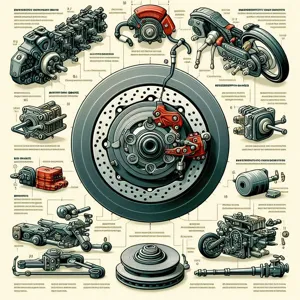
When it comes to motorbike safety, the brake system is arguably one of the most critical components. Understanding the various types of brake systems available can empower riders to make informed decisions about their bikes, enhancing both performance and safety on the road. Here’s an overview of the primary types of brake systems, each with its unique features and applications.
1. **Disc Brakes**: Disc brakes are the most common type of braking system found on modern motorbikes. They consist of a metal disc that rotates with the wheel and is squeezed by brake calipers when the rider applies the brakes. The advantages of disc brakes include superior stopping power, excellent heat dissipation, and consistent performance in wet conditions. They are favored for their responsiveness and reliability, making them ideal for both street and off-road riding.
2. **Drum Brakes**: While less prevalent in contemporary designs, drum brakes still find their place in certain motorbike models, especially in older bikes and some entry-level motorcycles. This system features a cylindrical drum that rotates with the wheel and is slowed by brake shoes that press against the drum’s inner surface. Drum brakes tend to offer good stopping power but can suffer from reduced effectiveness in wet conditions and tend to overheat with prolonged use. They are often more affordable and simpler in design, making them appealing for budget-conscious riders.
3. **Combined Brake Systems (CBS)**: Combining the best of both worlds, CBS is designed to enhance braking efficiency by linking the front and rear brakes. When the rider applies either the front or rear brake lever, the system distributes braking force to both wheels. This results in improved stability and control, especially for less experienced riders. CBS is particularly advantageous in emergency stopping situations, as it helps prevent skidding and maintains balance.
4. **Anti-lock Braking System (ABS)**: In recent years, ABS has become a popular and important feature in many motorbike models. This advanced technology prevents the wheels from locking up during hard braking, allowing the rider to maintain steering control and stability even in panic situations. ABS is especially beneficial in slippery conditions, reducing the likelihood of accidents caused by skidding. Many riders consider it a must-have for added safety on the road.
Each of these brake systems has its strengths and weaknesses, and the choice often depends on the type of riding you plan to do, your experience level, and your personal preferences. By understanding these different braking technologies, riders can not only enhance their safety but also optimize their motorbike’s performance to suit their needs. As you explore your options, consider how each system aligns with your riding style and the conditions you most frequently encounter.
4. Disc Brakes: Advantages and Disadvantages
When it comes to modern motorbike braking systems, disc brakes have become the gold standard, favored by both casual riders and seasoned enthusiasts alike. Their design consists of a flat, circular metal disc that is mounted to the wheel, which is clamped down by brake pads when the rider applies the brakes. This mechanism offers several compelling advantages.
**Advantages of Disc Brakes:**
1. **Superior Stopping Power:** Disc brakes provide excellent stopping power, even under harsh conditions. Their ability to dissipate heat quickly means they maintain consistent performance, reducing the risk of brake fade during lengthy descents or aggressive riding.
2. **Better Performance in Wet Conditions:** Unlike drum brakes, which can become less effective when wet, disc brakes tend to perform better in adverse weather. The open design allows water and debris to escape more easily, ensuring a reliable grip on the rotor.
3. **Easier Maintenance:** Disc brakes are generally easier to inspect and replace compared to drum brakes. The visibility of the brake pads and rotors simplifies the maintenance process, making it easier for owners to keep their systems in top shape.
4. **Lightweight:** The materials used in most disc brake systems, such as aluminum or carbon composite, help keep the overall weight of the bike down. This is especially important for performance motorcycles, where weight reduction can significantly impact speed and handling.
**Disadvantages of Disc Brakes:**
1. **Cost:** One of the primary downsides of disc brakes is their higher cost compared to traditional drum brakes. The initial investment can be a barrier for budget-conscious riders, particularly when considering aftermarket upgrades.
2. **Potential for Warping:** While disc brakes are robust, they are not immune to warping, especially if subjected to extreme heat or poor maintenance. A warped disc can lead to uneven braking and a pulsating feel when the brakes are applied, which can be both frustrating and dangerous.
3. **More Complex Installation:** Installing disc brakes can be more complex than drum systems, often requiring specialized tools and knowledge. This can deter some DIY enthusiasts from attempting their own upgrades or repairs.
4. **Dust and Debris Accumulation:** While disc brakes are generally resistant to the effects of dust and moisture, they can still accumulate debris over time. Regular cleaning is necessary to ensure optimal performance and longevity.
In summary, disc brakes offer a range of benefits that make them a popular choice among motorcyclists, delivering excellent stopping power and reliability under various conditions. However, potential drawbacks such as cost and maintenance considerations should also be taken into account when selecting the right braking system for your bike. Understanding these pros and cons will empower riders to make informed decisions tailored to their specific needs and riding styles.
5. Drum Brakes: How They Work and Their Effectiveness
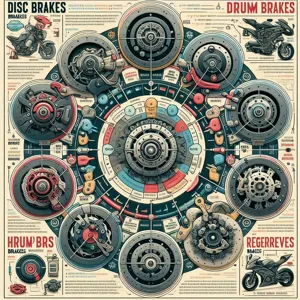
Drum brakes have been a staple in the world of motorbikes for decades, known for their reliability and effectiveness, particularly in certain riding conditions. Unlike the more modern disc brakes that many riders are familiar with, drum brakes consist of a cylindrical drum that rotates with the wheel. Inside the drum, a set of brake shoes is positioned against the inner surface. When the rider engages the brake lever, hydraulic pressure forces the shoes outward, pressing them against the drum’s interior, which generates friction and slows the bike down.
One of the key advantages of drum brakes is their ability to provide consistent stopping power in wet conditions. The enclosed design protects the braking components from dirt and water, reducing the likelihood of performance degradation. This makes drum brakes particularly effective for riders who often navigate through inclement weather or rough terrain.
However, it’s important to note that while drum brakes excel in certain scenarios, they do have their limitations. They tend to be less efficient than disc brakes in dissipating heat, which can lead to brake fade during prolonged use, such as in aggressive riding or downhill descents. Additionally, drum brakes are generally heavier and bulkier compared to their disc counterparts, which can impact the overall agility of the bike.
In terms of maintenance, drum brakes require regular inspections to ensure that the brake shoes are in good condition and properly adjusted. This maintenance is crucial for maintaining their effectiveness and ensuring rider safety. Despite their drawbacks, many motorcycle manufacturers still use drum brakes in certain models, particularly in entry-level bikes and cruisers, where their simplicity and durability make them a reliable choice.
In summary, drum brakes are a tried-and-true technology that offers reliability and performance for various riding conditions. Understanding how they work and their strengths can help riders make informed choices about their braking systems, contributing to a safer and more enjoyable riding experience.
6. Anti-lock Braking System (ABS): Enhancing Control and Safety
The Anti-lock Braking System (ABS) is a technological marvel that has revolutionized motorbike safety and control. Designed to prevent wheel lock-up during sudden braking, ABS allows riders to maintain steering control while decelerating. This is particularly crucial in emergency situations, where the instinct to brake hard can often lead to loss of control and potential accidents.
When a rider applies the brakes, ABS sensors monitor the wheel speed and detect if any wheel is about to lock up. If it senses that a wheel is losing traction, the system automatically modulates brake pressure—rapidly pulsing the brakes on and off—to maintain optimal traction. This process happens so quickly that the rider may not even notice it, but the benefits are substantial.
One significant advantage of ABS is its effectiveness on slippery surfaces, such as wet roads or loose gravel. Traditional braking systems can cause a bike to skid, but with ABS, riders can brake hard while maintaining their ability to steer, reducing the risk of skidding and improving overall safety. This feature has proven to be a game-changer, especially for new riders who may not have the experience to handle panic stops effectively.
Moreover, ABS is not just about safety; it also enhances performance. Riders can brake later and harder without the fear of losing control, allowing for more aggressive riding styles on the track or the road. This added confidence can lead to a more enjoyable riding experience, as it encourages a more strategic approach to braking and cornering.
In many countries, ABS is now mandatory on new motorbikes, highlighting its importance in promoting safer riding practices. If you’re considering a new bike, opting for one equipped with ABS can be a wise investment in your riding safety and skill development. With this system in place, you can ride with greater peace of mind, knowing that you have an added layer of protection should the unexpected occur.
7. Combined Braking Systems: Balancing Front and Rear Brakes
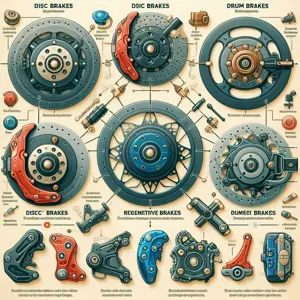
Combined Braking Systems (CBS) represent a harmonious blend of engineering ingenuity and rider safety, ensuring that both front and rear brakes work in unison to deliver optimal stopping power. Unlike traditional braking systems, which rely on separate controls for the front and rear brakes, CBS simplifies the braking process by linking the two. This means that when a rider engages the brakes—whether using the front lever or the rear pedal—both sets of brakes are activated to some degree.
The primary advantage of a CBS lies in its ability to distribute braking force more evenly between the front and rear wheels. This balanced application minimizes the risk of skidding, especially in emergency situations where split-second decisions are paramount. By engaging both brakes simultaneously, riders can maintain better control and stability, significantly reducing stopping distances.
Furthermore, CBS is particularly beneficial for less experienced riders who may struggle with the nuances of applying the right amount of pressure to each brake independently. By providing a more intuitive braking experience, CBS enhances confidence on the road, allowing riders to focus on navigating their journey rather than worrying about their braking technique.
In addition to improving rider safety, Combined Braking Systems can also contribute to tire longevity. When brakes are applied evenly, it prevents excessive wear on either the front or rear tire, promoting a more balanced wear pattern. This not only extends the lifespan of the tires but can also enhance overall ride quality.
As manufacturers continue to innovate, many modern motorbikes, especially touring and sport models, are now equipped with CBS as a standard feature. Whether you’re a seasoned rider or just starting out, understanding and utilizing a Combined Braking System can significantly enhance your riding experience, making every journey just a little bit safer.
8. Exploring Brake Materials: From Organic to Sintered
When it comes to motorbike brakes, the materials used in their construction play a pivotal role in their performance, durability, and overall effectiveness. Understanding the differences between these materials can help riders make informed decisions about their braking systems and enhance their riding experience.
**Organic Brake Pads** are typically made from a mixture of fibers, rubber, and resins. They are known for their quiet operation and excellent initial bite, making them a popular choice for everyday riders. These pads offer a softer feel, providing good performance in moderate conditions and are less abrasive on the rotors. However, they may wear down quicker than other materials, particularly in high-performance situations or extreme weather conditions, where their effectiveness can diminish under heat.
**Sintered Brake Pads**, on the other hand, are crafted from metallic particles that are heated and compressed. This process results in a denser, more durable material that excels under high temperatures, making them ideal for aggressive riding and racing conditions. Sintered pads provide excellent stopping power and are less prone to fading, even in wet or muddy environments. However, their increased hardness can lead to faster rotor wear and a noisier operation, which might not be desirable for every rider.
**Ceramic Brake Pads** offer a hybrid option, combining elements of both organic and sintered materials. They often provide a good balance between performance, noise reduction, and rotor wear. Ceramic pads are also less prone to dust production, keeping your wheels cleaner than other types.
Choosing the right brake material largely depends on your riding style, the conditions you encounter, and personal preference. By exploring the pros and cons of each type, riders can ensure they select the most effective braking solution for their motorbike, enhancing safety and performance on every journey. Whether cruising leisurely through the countryside or navigating tight turns on a racetrack, understanding the nuances of brake materials is essential for any motorbike enthusiast looking to rev up their knowledge.
9. Maintenance Tips for Optimal Brake Performance
Proper maintenance is crucial for ensuring your motorbike’s brake system operates at peak efficiency and safety. A well-maintained braking system not only prolongs the life of your bike but also enhances your riding experience. Here are some essential maintenance tips to keep your brakes in optimal condition:
1. **Regular Inspections**: Make it a habit to inspect your brakes regularly. Check the brake pads for wear and tear; if they are worn down to about 1/8 inch or less, it’s time for a replacement. Also, examine the brake rotors for any signs of warping or scoring, as these issues can significantly affect braking performance.
2. **Clean the Brake Components**: Dust, dirt, and debris can accumulate on your brake components over time, impacting their effectiveness. Use a soft cloth and brake cleaner to wipe down the brake pads and rotors, removing any contaminants that could hinder performance. Be gentle when cleaning to avoid damaging sensitive parts.
3. **Check Brake Fluid Levels**: The brake fluid is vital for hydraulic systems, and low levels can lead to brake failure. Regularly check the fluid reservoir and top it off as needed with the manufacturer-recommended fluid. Also, keep an eye out for any leaks in the system, as this can indicate a more significant issue.
4. **Bleed the Brakes**: Over time, air can get trapped in the brake lines, leading to a spongy feel when you squeeze the brake lever. Bleeding the brakes helps remove any trapped air, ensuring a firm and responsive braking action. This should be done periodically, especially if you notice a decrease in brake performance.
5. **Adjust Brake Calipers**: For bikes equipped with mechanical brakes, ensuring that the calipers are correctly aligned and adjusted is crucial. Misalignment can lead to uneven wear on the brake pads and rotors. Follow the manufacturer’s guidelines for proper adjustment.
6. **Monitor Brake Performance**: Pay attention to how your brakes feel while riding. If you notice any unusual sounds like grinding or squeaking, or if the braking response feels inconsistent, address it immediately. These could be signs of worn components or the need for further maintenance.
7. **Professional Servicing**: While some maintenance tasks can be handled by the owner, it’s wise to seek professional servicing at least once a year. A qualified mechanic can provide a thorough inspection and address any issues that may not be immediately apparent.
By following these maintenance tips, you can ensure that your motorbike’s braking system remains reliable, responsive, and safe for all your riding adventures. A well-maintained brake system not only enhances your confidence on the road but also protects you from potential hazards, allowing you to focus on the thrill of the ride.
10. Upgrading Your Brake System: What You Need to Know
Upgrading your brake system can be one of the most impactful modifications you make to your motorbike, enhancing both performance and safety. However, before you dive into any upgrades, it’s essential to understand the different components involved and how they interact with each other.
First off, consider the type of brake system currently on your bike. Most modern motorcycles come equipped with either disc brakes or drum brakes. Disc brakes, known for their superior stopping power and heat dissipation, are a popular choice among riders looking for improved performance. If your bike currently features drum brakes, upgrading to a disc brake system can significantly enhance your braking efficiency, especially in high-speed scenarios or during aggressive riding.
Next, think about the materials used in your brake components. Upgrading to high-performance brake pads made from advanced materials like carbon-ceramic or sintered metal can provide better grip and reduced fade, particularly under heavy braking. Additionally, consider replacing your stock rotors with aftermarket options that offer improved heat management and reduced weight, which can lead to quicker stopping times and a more responsive feel.
Another crucial aspect to assess is the brake lines. Standard rubber lines can expand under pressure, leading to a spongy brake feel. Upgrading to stainless steel braided lines can offer a firmer, more responsive braking experience, as they are less prone to expansion. This upgrade is particularly advantageous for riders who frequently engage in spirited riding or track days.
It’s also important to keep in mind that upgrading your brake system is not just about the components; it’s also about ensuring compatibility with your bike’s overall setup. Consult with a professional mechanic or a knowledgeable retailer to ensure that the parts you select work harmoniously with your current system.
Lastly, remember that an upgraded brake system is only as effective as the rider operating it. Take the time to practice with your new components in a controlled environment before hitting the road. Understanding the nuances of your upgraded brakes will not only enhance your confidence but will also ensure you can maximize the effectiveness of your modifications.
In summary, upgrading your brake system can transform your riding experience, but thorough research and consideration are essential to make informed decisions that will enhance both safety and performance on the road.
11. The Role of Brake Fluid in Performance
Brake fluid plays a crucial role in the overall performance of motorbike brakes, acting as the lifeblood of the braking system. When you squeeze the brake lever, you’re not just applying pressure; you’re initiating a hydraulic process that relies entirely on the properties of the brake fluid. This fluid transmits the force from the lever to the brake calipers, where it compresses the brake pads against the rotors, ultimately slowing down or stopping the bike.
One of the key functions of brake fluid is its ability to maintain a consistent pressure under varying temperatures. Unlike other fluids, brake fluid is designed to withstand high heat generated during braking without vaporizing. This is particularly important because if the fluid boils, it can lead to a phenomenon known as brake fade, where the brakes lose effectiveness due to the formation of gas bubbles in the braking system. High-performance bikes often utilize specialized brake fluids with higher boiling points, ensuring that riders can rely on their brakes even during intense riding conditions.
Moreover, the composition of brake fluid is critical. Most motorcycle brake fluids are either glycol-based (DOT 3 and DOT 4) or silicone-based (DOT 5). Glycol-based fluids are hygroscopic, meaning they absorb moisture over time, which can reduce their effectiveness and lead to corrosion within the braking system. As such, regular fluid changes are essential for maintaining optimal performance. On the other hand, silicone-based fluids do not absorb moisture but can create air bubbles more easily, which may affect braking efficiency.
In addition to performance, the type and condition of brake fluid can influence the overall safety and longevity of your bike’s braking system. Regularly checking the fluid level and ensuring its cleanliness can prevent costly repairs and keep you safe on the road. In summary, understanding the pivotal role of brake fluid in your motorbike’s braking system is essential for any rider looking to rev up their knowledge and enhance their bike’s performance.
12. Understanding Brake Fade and How to Prevent It
Brake fade is a phenomenon that every motorcycle rider should be aware of, as it can significantly compromise your safety on the road. It occurs when the brake system overheats, leading to a reduction in braking effectiveness. This overheating is often caused by prolonged use of the brakes, particularly during steep descents or aggressive riding. As the brake components, such as the pads and rotors, heat up, the friction material can begin to break down, resulting in a loss of grip and responsiveness.
Imagine barreling down a winding mountain road, the adrenaline coursing through your veins as you conquer each curve. But as you press down on the brake lever, you feel a disconcerting softness; the brakes aren’t responding as they should. This is brake fade in action, and it can turn an exhilarating ride into a dangerous situation in the blink of an eye.
Preventing brake fade requires a combination of proper maintenance and smart riding techniques. First and foremost, ensure that your brake system is in good working order. Regularly check the condition of your brake pads, and replace them before they wear down too much. Additionally, keep your brake fluid fresh, as old or contaminated fluid can contribute to overheating.
On the riding front, consider adjusting your braking technique. Rather than holding the brake lever down continuously, practice using engine braking to reduce speed. This involves downshifting to lower gears, which utilizes the engine’s resistance to slow the bike down, thereby reducing the strain on your brakes. When navigating steep inclines or engaging in spirited rides, it’s essential to give your brakes a moment to cool down; this might mean taking a break during a long descent or spacing out your braking intervals.
By understanding brake fade and implementing these preventive measures, you can protect your safety and enhance your riding experience. Remember, the goal is not only to enjoy the thrill of the ride but to do so with the confidence that your bike’s brakes are up to the challenge.
13. Real-World Testing: Performance Comparisons of Brake Types
When it comes to motorbike brakes, understanding their effectiveness in real-world scenarios is crucial for every rider, whether you’re a weekend warrior or a daily commuter. Real-world testing provides invaluable insights into how different brake types perform under various conditions, shedding light on their strengths and weaknesses when it matters most.
In controlled environments, such as testing tracks, brake types like disc and drum brakes can be evaluated based on metrics like stopping distance, fade resistance, and heat dissipation. However, these conditions don’t always mimic the unpredictability of the road—sharp turns, sudden stops, and wet surfaces can significantly alter a brake’s performance.
For instance, many riders have found that hydraulic disc brakes offer superior stopping power and modulation, especially during emergency situations. In a test comparing hydraulic discs to mechanical ones, riders reported a noticeable difference in responsiveness. While mechanical disc brakes can be effective, they often require more force on the lever, which can lead to fatigue on longer rides.
Drum brakes, though often considered outdated, can still hold their ground in certain environments, especially on lighter bikes or in vintage models. However, in our tests, they tended to exhibit more fade under continuous heavy braking, particularly in hilly terrains. This is largely due to their design, which can trap heat more effectively than disc brakes.
Furthermore, the conditions of real-world riding—such as rain-soaked roads or sandy trails—play a significant role in how brakes perform. Riders have reported that while disc brakes excel in wet conditions, providing reliable stopping power, drum brakes can struggle with moisture retention, leading to decreased effectiveness.
Ultimately, real-world testing reveals that while specifications and designs play a part, individual experience and riding style greatly influence brake performance. Riders should consider their typical riding conditions and personal preferences when selecting their brake systems. Understanding these dynamics can empower you to make informed decisions, ensuring your ride is not only exhilarating but also safe.
14. Conclusion: Choosing the Right Braking System for Your Ride
In the exhilarating world of motorbikes, choosing the right braking system is as crucial as selecting the perfect machine for your riding style. With various types of brakes available, each offering unique benefits and characteristics, it’s essential to weigh your options carefully before making a decision.
Disc brakes, known for their superior stopping power and heat dissipation, are ideal for high-performance bikes and those who crave spirited rides on twisty roads. Their responsiveness can provide the confidence needed to tackle demanding conditions. In contrast, drum brakes, while often seen as outdated, still hold their ground in specific applications, particularly in lower-speed and vintage models, where their simplicity and durability can be advantageous.
Moreover, the advent of advanced braking technologies, such as Anti-lock Braking Systems (ABS) and Combined Braking Systems (CBS), has transformed the riding experience, enhancing safety and control. ABS prevents wheel lock-up during hard braking, offering a safety net for riders navigating slippery surfaces. CBS distributes braking force between the front and rear wheels, ensuring balanced stopping power and reducing the risk of skidding.
Ultimately, the right braking system for your ride depends on your individual needs, riding style, and the type of motorcycle you own. Whether you’re a city commuter, a weekend warrior, or an off-road adventurer, understanding the strengths and limitations of each braking system will empower you to make an informed choice. As you embark on your next ride, remember that effective braking is not just about stopping; it’s about enhancing your overall riding experience and ensuring your safety on the open road. Choose wisely, and enjoy the freedom that comes with confident braking!
15. Resources for Further Learning on Motorbike Brakes
As you embark on your journey to better understand motorbike brakes and enhance your riding experience, a wealth of resources awaits you. Whether you’re a novice rider eager to learn the basics or an experienced enthusiast looking to deepen your knowledge, there are numerous avenues to explore.
**Online Courses and Tutorials:** Websites like Udemy and Coursera offer specialized courses that delve into motorcycle mechanics, including detailed modules on braking systems. These courses often feature video lectures, interactive quizzes, and forums where you can engage with instructors and fellow riders.
**YouTube Channels:** For visual learners, YouTube is a treasure trove of content related to motorbike brakes. Channels such as “MC Garage” and “RevZilla” provide in-depth tutorials, breakdowns of different braking systems, and maintenance tips. Watching seasoned mechanics demonstrate brake repairs and upgrades can significantly enhance your understanding.
**Books and Manuals:** Consider investing in books that focus on motorcycle mechanics. Titles like “The Essential Guide to Motorcycle Maintenance” and “Motorcycle Basics Techbook” offer comprehensive insights into braking systems, along with practical advice on maintenance and troubleshooting. Manufacturer-specific service manuals are also invaluable for understanding the intricacies of your particular model’s braking system.
**Forums and Online Communities:** Joining motorcycle forums such as Adventure Rider or Motorcycle.com allows you to connect with like-minded individuals who share your passion. Engaging in discussions about brakes, asking questions, and sharing experiences can provide you with practical insights and tips that are often not found in textbooks.
**Workshops and Local Classes:** Many motorcycle shops and riding schools offer hands-on workshops that focus on bike maintenance, including brake systems. Participating in these workshops not only helps you gain practical skills but also allows you to meet fellow enthusiasts and industry professionals.
**Manufacturer Resources:** Don’t forget to check the websites of bike manufacturers. Many offer detailed resources, including videos and technical papers, that explain the features and benefits of their braking systems. This can be especially useful if you’re considering upgrading or replacing components.
By tapping into these resources, you’ll not only rev up your knowledge about motorbike brakes but also enhance your overall riding safety and enjoyment. Understanding the nuances of braking systems empowers you to make informed decisions, ensuring that each ride is not just thrilling but also secure.
As we bring our exploration of motorbike brakes to a close, we hope you now have a comprehensive understanding of the various types available and their unique effectiveness. From the reliable simplicity of drum brakes to the advanced technology of anti-lock braking systems (ABS), each type offers distinct advantages suited to different riding styles and conditions. By arming yourself with this knowledge, you can make informed decisions that enhance your safety and performance on the road. Whether you’re a seasoned rider or a newcomer to the motorbike world, understanding your brakes is crucial for maximizing your riding experience. So, take these insights with you as you rev up your journey, and remember: safety and knowledge go hand in hand. Happy riding!





